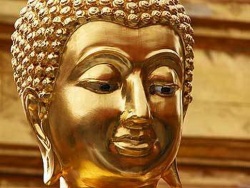Sujata
Pali tradition believes that every Buddha was offered milk-rice from some maiden just before his Enlightenment. For example, Vipassi Buddha accepted the milk-rice from Daughter-of-Sudassana-Setthi; Sikhi Buddha accepted it from Daughter-of-Piyadassi-Setthi; Vessabhu Buddha accepted the milk-rice from Sirivaddhana; Kakusandha Buddha accepted the milk-rice from a brahmin girl Vajirindha of the village Suchirindha; Konagamana from a Brahmin woman Aggisoma; and Kassapa Buddha from his wife Sunanda. Last in the list is Gotama Buddha, who accepted the milk-rice from Sujata. Separating from the five monks with whom Gotama had undertaken several ascetic penances in Uruvela for the Enlightenment after having left his two gurus, namely, Alara Kalama and Uddaka Ramaputta, he sat under a banyan tree called the Ajapala Nigrodha. As he felt that the extreme austerities for the spiritual achievement was not a necessary condition to realise the spiritual goal, the natural human drive for the normal human food once again became operative in him. His desire was, however, fulfilled by a woman named Sujata, who offered him the milk-rice.
Sujata, a daughter of the landowner of the village Senani near Uruvela had once pledged that she would offer the milk-rice to the spirit of the tree if she gave birth to a son. As her wish was fulfilled she asked her maid Punna to visit the tree and prepare the place for offering. When Punna visited the place she saw Gotama sitting under the tree. She then mistook him to be the tree-deva and reported the matter to Sujata, who in a great joy reached the spot and offered him the milk-rice in a golden bowl.
Gotama accepted the bowl; walked to the river-bank; bathed in the Suppatthita; and then ate the food. This was his only meal after the gap of forty-nine days.
See Digha Nikaya ii.135;Sutta Nipata Commentary 1.154; Dhammapada Atthakatha 1.71.
